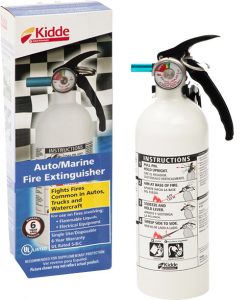
A new U.S. Coast Guard regulation for disposable fire extinguishers mandates a 12-year expiration date from the
A new U.S. Coast Guard regulation beginning April 20 for disposable fire extinguishers mandates a 12-year expiration date from the date of manufacture. The manufacture date is stamped into the bottom of the bottle or near the UL label. This may be two or four digits — if it is two, as in 08, that means 2008.
Additionally, while the new regulation does not change the type (U.S. Coast Guard-rated) or quantity or requirement for USCG approved fire extinguishers aboard, it does specify the minimum Underwriter Laboratory (UL) classification of extinguishers to be carried aboard certain vessels — depending on the boat’s model year.
This is the result of phasing out older “B-I” and “B-II” labels for newer “5-B” “10-B” and “20-B” extinguisher classifications. The number in this new rating refers to the size in square feet of the potential fire the device is suitable to extinguish, and not the exact weight of the dry chemical inside the bottle.
Vessels on the water today that are under 26 feet and model year 2017 or older may continue to carry older, dated or undated “B-I” or “B-II” disposable extinguishers. However, when they are no longer serviceable or have reached 12 years of age since manufacture, they must be replaced with newer class “5-B” or greater extinguishers. Boats less than 26 feet and 2018 model year or newer must carry unexpired “5-B” “10-B” or “20-B” fire extinguishers. Having older “B-I” and “B-II” types do not meet the new requirements.
“10-B” class extinguishers may be a good choice as they exceed U.S. Coast Guard minimum carriage requirements for boats under 26 feet, while at the same time giving boaters more extinguishing coverage. For boats 26 feet or greater, however, having one “10-B” aboard does not equal two 5-Bs. Only a “20-B” classification meets the requirement to carry two “5-B” extinguishers.
To be serviceable, a portable extinguisher must have a pressure gauge indicating an operable range, lock pin firmly installed, clean discharge nozzle, and no significant corrosion or damage. Some more recently manufactured portable fire extinguishers aboard boats today may carry both old and new labeling, for example, having simultaneous “B-I” and “5-B” classifications.
For more information, visit uscgboating.org. ■



